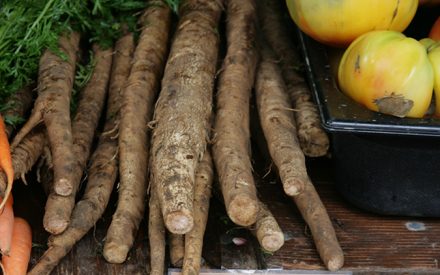In this video, Andy Larson, farm financial consultant with the Food Finance Institute and also the Wisconsin Small Business Development Centers, talks about helping aspiring rural entrepreneurs examine the feasibility of a business idea. His goal is to help you quickly make a preliminary go or no go decision on a potential business enterprise using an enterprise budget, so you don’t waste a lot of effort pursuing an idea with a low likelihood of success.
Transcript
Hello folks, thanks for joining us for this rural entrepreneurship video series. My name is Andy Larsen. I’m a farm financial consultant with the Food Finance Institute and also Wisconsin Small Business Development Centers. We are a part of the Institute for Business and Entrepreneurship within the University of Wisconsin System. And I give a lot of things to my collaborators at the University of Wisconsin Division of Extension for making this video series possible.
So my task with this brief little presentation here is to help aspiring rural entrepreneurs like yourself, examine the feasibility of a business idea. Feasibility is really just a fancy word for predicting the likelihood of success given existing context and constraints. To put it simply, I want to help you make a preliminary go or no go decision on a potential business enterprise, so you don’t waste a lot of effort pursuing an idea with a low likelihood of success.
The first step in determining the feasibility of a business idea is objectively defining what success looks like, preferably using measurable numbers. Unsurprisingly, time and money tend to be most people’s biggest constraint. So I encourage entrepreneurs to set a realistic profit objective, and a specific amount of time they can devote to meeting this objective.
As a side note, there may well be parts of your business concept that are harder to quantify, for example, being your own boss or leaving the world a better place or creating a legacy for your children. These statements generally represent deeply held values. And they’re probably a big part of the reason you want to go into business in the first place. Such things certainly have a place in your definition of success. But for the purposes of this video, I want you to remember a couple things.
One, you don’t manage what you don’t measure. So placing a measurable benchmark that indicates progress towards these types of objectives is extremely useful. And two, your business cannot serve the greater good in the long term, if it’s not a sustainable, profitable venture within the first few years. As such, you need a business model that makes money and that’s what we’re going to talk about today.
So let’s say you want to replace half your salary from a full time job in town with the profits from a home-based food business or farm business, let’s call it $25,000. You could certainly have a higher or lower number depending on others you know, avoiding expenses or lifestyle benefits that come along with having your own business. But that income objective is necessary to determine the scale of your intended business venture. The only thing that will help determine scale is how much time you have to devote to your intended business.
Since we’re replacing a halftime salary here, let’s assume you have a maximum of about 20 hours a week available. Again, your number could be higher or lower, depending on your desired lifestyle. Lots of folks out there would prefer to work less hours if they could. So let’s examine briefly two examples of common Food and Farm based startup businesses. The first will be a poultry enterprise for you acreage owners raising pastured meat chickens, which are commonly known as broilers. The second will be a home baking enterprise making artisan bread from local organic flour. For both examples, we’ll use the farmers market as the preferred sales channel simply due to low barriers to entry and full retail prices for most of the products available.
The next step in determining the feasibility of a food or farm business is to come up with a preliminary enterprise budget for each good or service that you intend to provide. A farm enterprise budget starts with sale price minus cost of production, and a non farm enterprise budget will begin with the sale price minus cost of goods sold or cogs.
Well, cost of production and cost of goods sold are pretty similar concepts. A prominent difference is that a farm enterprise tends to grow the product it sells whereas the non farm enterprise tends to make the product to sales using purchase materials or ingredients. Either way, per unit sale price minus per unit cost to produce is the most fundamental indicator of the feasibility of any business model.
The resulting number is called gross profit, and it has to be a positive for a business model to be feasible in the long term. Otherwise, it means there’s no money leftover to pay for the other expenses of the business. These other expenses are going to include things like direct cost of operating the enterprise like fuel, or repairs, and also overhead cost of simply being in business like commercial liability insurance or annual licensing fees.
Gross profit has to be enough to cover both operating and overhead expenses in order to have a net profit there on the bottom line. Net Profit is what the proprietor gets to keep, and contributes towards the $25,000 profitability goal. That said, for the purposes of this video here, we’re not going to delve too deeply into the details of operating or overhead costs, we don’t want to get bogged down, we’ll talk about resources to help you estimate these for the purposes of projecting your financial plan. But right now, let’s focus on the top part of that enterprise budget.
So let’s start with the poultry example for the poultry enterprise. The first thing you need to find out is the sale price of a pastured broiler at the farmers market. In a more rural marketplace in the Upper Midwest where I live, I’d expect whole process broilers would be able to sell pretty easily for about five bucks a pound. Total carcass weight, about four pounds gives you a sale price of right around 20 bucks a bird. Of course, that means it has to cost you less than $20 to produce. The cash costs of production for each broiler chicken are going to consist primarily of the cost of the chick, cost of the feed, and the cost of getting it processed for market. Let’s say the chicks are just conventional Cornish cross broilers from the local farm store, they cost $2.50 each. Over the course of eight weeks on your farm, each bird is going to eat probably 15 pounds of feed at a cost around 40 cents a pound if you’re buying it from that same farm store for a total feed cost right around six bucks a bird.
Now there is labor involved too, of course, but let’s assume you as the proprietor are providing the labor yourself. Therefore, you never really have to write anyone else a paycheck. Once your birds have finished out, they will need to be transported to the processor for butchering. And that’s going to cost you probably about $5.50 each. There’s also a transport expense of driving the birds to and from the processor and onto the farmers market. But since this can vary pretty drastically depending on the distance, depending on the number of birds transported with each trip, we’re just going to opt to account for those in the direct operating costs below the gross profit line instead of in the cost of production.
So if each $20 of sales costs you $14 to produce, that means that there is a gross profit of $6 left, which is a 30% gross profit margin. For the moment, let’s ignore our other costs and think about how many units you would need to produce at bare minimum in order to meet your profit objective. It’s just to see if we’re kind of on the right track. It places some realistic context around the numbers. So if you’re raising meat birds on pasture, in Salatin-style chicken tractors, each one is going to hold about 80 broilers, so you need to fill at least 52 Chicken tractors over the course of the pasturing season.
If you live in the Upper Midwest, you’re pasturing seasons only probably around six months 26 weeks. This is enough time to raise three batches of broilers when each batch takes approximately eight weeks. If we also assume you know, a death loss probably in the neighborhood of 5%. This means you need to run at least 18 Chicken tractors full of boilers in each of those three batches. Just as a reminder, this is only including cost of production and profit, with no operating overhead expenses considered so the actual number could be considerably higher.
So far, we have used our profit goal and our gross profit per unit to roughly approximate a scale for your enterprise. Now, we have to determine whether the size of this enterprise can fit into your time and resource constraints. If you only want to spend 20 hours a week on this operation, livestock inherently requires chores seven days a week. That means you’ve got less than three hours a day to get it all done. Do you have enough pasture to accommodate 18 Chicken tractors moving to fresh forage every day? Can you move all 18 Chicken tractors, fill 18 feeders and fill 18 waters and just basically do routine inspections and wellness checks all in under three hours a day in all kinds of weather conditions. Plus, do you have enough additional time to transport the birds to the processors and back every couple of months?
And remember, the profit does not occur simply from raising and processing the birds for market they have to get sold. So do you have time to devote to transporting frozen birds to the farmers market and standing there selling for five to six hours each week?
Another essential question to ask is whether your market can actually absorb the amount of chickens you would need to sell to meet your objectives. If your market is 26 weeks, and you need to sell 4167 Birds total, you need to sell 160 chickens a week, probably more to make up for those weeks where it rains and fewer customers show up. If you find a year round farmers market that operates weekly you could cut the number of chickens sold down to 80 or so per week. But in a temperate climate, your production is still going to be concentrated during the growing season if you want to have truly pastured broilers. For this example, it sounds like the scale of production is plausible. But adding the processing and market days might push the time commitment beyond the 20 hours a week anticipated.
It’s time to start asking a couple of questions. Are our goals flexible? Can we tweak the business model to better fit our goals? So for example, if we butchered the birds on the farm personally, rather than going to a commercial facility, would that save us any time or any money? Would we still be able to sell the birds away from the farm at the farmers market? Can we raise our sticker prices or lower production costs and therefore raise and sell fewer chickens? Would that smaller number of chickens really change the time commitment so this business model might work? But it definitely requires some refinement, and then a thorough investigation into the other costs to run the enterprise.
Now let’s consider a second example: a home-based artisan bread-baking business using locally milled organic flour. So let’s assume the same desire for about $25,000 worth of income on a 20-hour-per-week time commitment and the farmers market is the preferred sales channel in this case, probably using a cottage food exemption. So one pound loaves of artisan bread should readily command a $5 price at most farmers’ markets in the upper Midwest. Let’s assume that you use three and a half cups of about a pound of organic bread flour at a cost of two bucks a pound. You’re also gonna have other ingredients, about a dollar’s worth of yeast, salt, and any other herbs or spices you might be thinking about, the utility is that it takes to run the oven, but utilities are often difficult to tease out for a home-based business. So the cost of gas or electricity to run the oven will probably end up in our operating costs, as will the cost of mileage to the farmers market.
So for simplicity sake a $5 loaf of artisan bread minus $3 Cost of Goods Sold yields $2 in gross profit per loaf sold. As such, 25,000 bucks in profit would require selling at least 12,500 loaves or 480 loaves per week for a 26 week Farmers Market season. Even if you can reasonably expect your market to absorb 481 loads a week, that would require you to make about 96 loaves per day if we assume you’re baking five days a week because the other two days probably be reserved for making dough selling at the market etc.
So even if your home oven could bake two loaves at a time and each pair took 30 minutes to bake, you’d have to bake 24 hours a day five days a week to produce the number of loaves required to achieve a $25,000 profit. If you were interested instead selling it a year round farmers market that operated weekly, you could cut this down to about 240 loaves a week and 12 hours a day for five days a week. But either way, this really doesn’t fit the available 20 hour per week time commitment that you talked about at the beginning.
So again, you could raise your prices or reduce your costs. But it’s still not going to make this business model feasible in your home kitchen. It would likely require some commercial baking equipment and a dedicated space to produce 481 loaves a week efficiently. And realistically, it probably requires several farmers market days to get that many loaves sold in anything short of a relatively large metropolitan area.
So at this point in the process, you’ve used your income goal and a gross profitability analysis to estimate the scale of your enterprise just preliminarily and considered whether that scale can fit your time, your resources and your market constraints. If the business model doesn’t sound good yet, play with the numbers a bit.
Can you lower your production costs, increase your prices, sell in a different market? Can you contribute a little more time or perhaps lower your income expectations at least early on? If no amount of reasonable tweaking can make the business model work in your situation then it’s time to stop. The enterprise isn’t feasible, and it’s probably not the right business for you. Time to move on to the next idea. However, if the business model sounds attractive, and you’re even more excited to pursue it than you were when you started this exercise, then it may well be feasible. And it’s time for the serious planning to begin.
You’ll need to make a more detailed accounting of operating and overhead costs. In order to make financial projections. For the next couple of years, you’ll need to pull together market research that supports the idea that your marketplace will actually buy what you produce in the quantity you make available. You’ll need to start building a brand identity that aligns with your values and your mission and to which your customers could hopefully become loyal. And you’ll need to start finding those customers. All of these things are unfortunately beyond the scope of this particular little video. But all of this and more will be addressed in the rest of this series.
Rest assured that the information you need to build a helpful business plan is out there. And if you don’t know where to find it, start to build your supporting network of business advisors. Now, groups like the Small Business Development Centers, or SCORE or other economic development organizations can be really valuable for entrepreneurs trying to ground truth the business idea and hopefully build it into a full fledged business and marketing plan, sometimes even at no charge.
If you want more information on developing a rural food or farm business, please drop by the Extension Farm Management page. In addition to all the financial tools and templates, you can click on that business development link and peruse a whole section on beginning farm and enterprise development or swing by edible alpha, which is where FFI keeps all of its archives of articles, podcasts, webinars, and a whole slew of other food entrepreneurship topics. Once again, thanks for joining us for this rural entrepreneurship video series. I’m Andy Larsen with the Food Finance Institute and Wisconsin Small Business Development Centers.
Take the next step by
Filling out a Pro Forma Budget (download)

 Organic Transition: Purpose, Process, and Resources
Organic Transition: Purpose, Process, and Resources Partnerships for Your Food or Farm Business
Partnerships for Your Food or Farm Business Finding the right people
Finding the right people Permits, licenses, and labels
Permits, licenses, and labels


